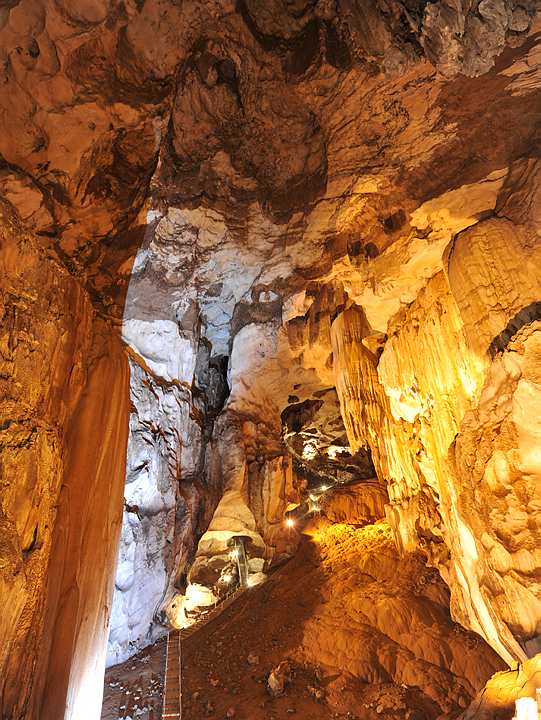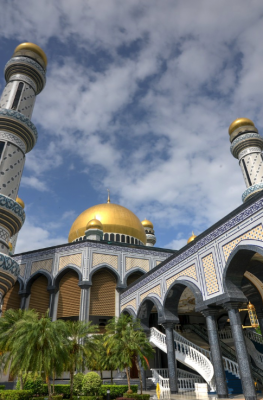Published on May 10, 2010

When my guide said it was going to be dark once I turned off my headlamp, he really meant it. Even after a few minutes my eyes had not adjusted, because there simply wasn’t any light at all this far into the Racer Cave—one of many caves in Gunung Mulu National Park, this one named after the bat-eating snakes (reassuringly harmless to humans), which we had already seen coiled on stone ledges.
It was chilling to consider that without light, there was no way I would ever make it out of there. I was at the mercy of my equipment and my guide. Soon, thankfully, we had turned our lamps back on and were clambering our way out using ropes that had been attached to the rocks. I found it hard going, even though it was one of the easiest “adventure caving” options on offer.
A UNESCO World Heritage site, the national park can boast some remarkable underground riches including the Sarawak Chamber—the world’s largest known underground chamber at around 700m long, 400m wide, and 70m high. That’s big enough to house 40 Boeing 747 aircraft.
Experienced cavers can explore the chamber on an adventure caving trip, and even beginners can go if they first prove their mettle in an easier cave. Most visitors to Mulu, however, don’t don a helmet at all and are content with the park’s four “show caves,” which require no equipment or experience.
Cave tours are scheduled so that it’s possible to arrive at the park headquarters in the morning and visit two of the caves that afternoon, stay overnight, then see the other two caves next morning before flying out little more than 24 hours after arrival. I would not, however, recommend this unless time really is tight. For one thing, it just wouldn’t be very relaxing. For another, it would mean missing out on some of the other things that the park has to offer both above and below ground, including a vertiginous walkway high up in the jungle canopy and adventurous overnight treks.
After checking into the headquarters, it was soon time to head out for my first show cave tour. Wooden pathways lead through the jungle, making it easy to explore, and on the way my guide (compulsory for all caves) pointed out interesting plants and animals.
Our first stop was at the Lang’s Cave, a good place to observe distinctive cave features such as stalactites and stalagmites. Signboards explained how these structures would be formed over unimaginable lengths of time by the mineral content of dripping water. Along with the park guides, these signboards help to impart a real understanding of the formation of the show caves.
The first cave had been impressive enough, but the next was jaw-dropping: the famous Deer Cave, until recently the largest known cave passage in the world at a remarkable two kilometers in length. There was something surreal about the combination of the enormous scale and the eerie light filtering in from the huge main opening. Watching the tiny figures crossing the passage on a walkway somehow reminded me of a painting of hell.
This otherworldly feeling was enhanced by the smell of ammonia, coming from the huge expanses of bat guano (droppings) that coated much of the cave floor. The afternoon tour is timed to end with the exodus of bats as they go out hunting, and sitting outside we were treated to the sight of hundreds of thousands of bats streaming out in swirling ribbons. Up to 3.5 million are believed to live in the cave.
The next morning began with a boat trip down the Melinau River, with a brief stop at a village inhabited by the Penan tribe. Once semi-nomadic, they have been forced to settle due mainly to logging and the development of palm oil plantations. We had the chance to buy handicrafts from their market but it certainly didn’t offer an insight into the tribe’s culture and current problems.
We soon moved on to the Cave of the Winds, once used as a burial site and renowned for the large King’s Chamber with its towering columns. Information boards explained that the direction of finger-like growths of rock is actually influenced by breezes passing through the cave.
The final stop was Clearwater Cave, with rounded chambers indicating water erosion, and sure enough its most distinctive feature is an underground river that continues for over 108 kilometers. As I dipped my hand in the cool water, I realized that the four caves had whetted my appetite for more. Which is how, a couple of days later, I found myself clinging to a rope in Racer Cave and trying to explain to my guide that—no—there was just no way I could get my arm over there and my leg up here…

Caving Essentials
The park headquarters provides equipment for adventure caving, while the show caves require no particular equipment. It would, however, be a good idea to bring a torch along for spotting details in the dark. Wear shoes or sandals rather than flipflops that may slip on wet surfaces.
Go
From Kota Kinabalu, by far the easiest way to Mulu is by air with MASwings (http://www.maswings.com.my) although it is also possible by boat from Miri.
Stay
Accommodation at the park headquarters (http://www.mulupark.com) includes both private rooms and dormitories. There is a decent café on site. The other option is to stay in the nearby Royal Mulu Resort (http://www.royalmuluresort.com), a much more up-market place run by the same company. Visitors should be aware that the resort’s construction on Penan tribal lands has been very controversial (see http://www.bmf.ch/en).
This article was provided by Philippine Airlines’ Mabuhay Magazine.Mabuhay Magazine is published by Eastgate Publishing Corporation (email:info@eastgatepublishing.com;website: http://www.eastgatepublishing.com).
John Oates is a freelance writer/photographer and has travelled through much ofAsia. He recently spent a year based inthe Philippines while visiting several other ASEAN countries.Contact John athttp://www.johnoates.co.uk.






